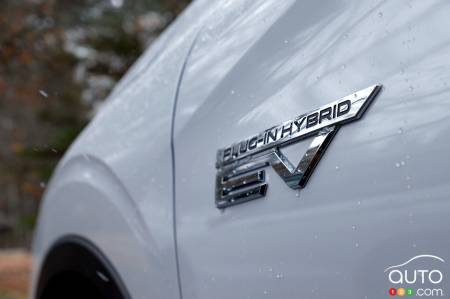Over the next four weeks, we'll be getting to know the 2024 Mitsubishi Outlander PHEV a little better. This is the first chapter of our long-term test of the SUV.
By now, you know what PHEV stands for: Plug-in Hybrid Electric Vehicle. Anyway, when it arrived in 2013, the Outlander compact SUV created a bit of a revolution. Let's start by putting it in context...
Mitsubishi has been selling cars in Canada since 2002; 22 years later, its 2024 range includes five models. In addition to the Outlander PHEV, there's its gasoline-powered sibling, the Outlander, two other SUVs, the Eclipse Cross and the RVR, and finally the Mirage, an extremely rare compact sedan in a market that is squeezing them out one after the other. This will be the Mirage's fate as well, since the 2024 model-year represents its last in Canada.

Portrait in figures
The Outlander duo has a lot of pressure on its shoulders, as it is the undisputed star of the brand's small Canadian portfolio. Last year, Mitsubishi sold 35,708 vehicles, an increase of 61.2 percent over 2022 and a new record for the Canadian market. Of the total, the two Outlanders accounted for 19,551 units - 9,640 gasoline-powered Outlanders and 9,911 PHEV variants.
In other words, Outlanders accounted for more than half (55 percent) of Mitsubishi's total sales in Canada in 2023.
Internationally, according to a table showing global sales of light vehicles by the 16 leading automakers in 2023, Mitsubishi ranked 16th with 789,000 sales.
By way of comparison, Mazda and Tesla occupied 15th and 14th place with 1.2 and 1.8 million sales respectively, while Toyota (including Lexus) dominated the ranking with over 11 million sales.
It also means that Canada accounted for 4.5 percent of Mitsubishi's worldwide sales in 2023.
If these statistics give you the impression that Mitsubishi is a small player in the global automotive industry, you're not wrong. But it's also interesting to note that Mitsubishi Motors is just one link in the Mitsubishi Group. And that group is no slouch.

Once upon a time...
Its origins date back to 1870 as a shipping company. Subsequent expansion transformed the company into a zaibatsu, a Japanese word meaning a grouping of several companies owned by the same family. The Mitsubishi Heavy Industries division alone was involved in electricity, nuclear power, chemicals, optics (the renowned Nikon brand) and automobiles. In fact, as early as 1917, the Mitsubishi Shipbuilding Company launched the Model A, the first automobile marketed in Japan.
Entirely hand-built and capable of carrying seven occupants, the Model A sedan's career spanned four years and… 22 units built. Nevertheless, a crucial milestone in Japanese automotive history had just been reached.
At the end of the Second World War, the Allies broke up the Mitsubishi Group. In 1954, Mitsubishi Corporation (part of the former Group) rose from the ashes, and Mitsubishi Heavy Industries also returned to the automobile business. The success of the Galant in 1969 prompted MHI to create a division that would focus solely on automobiles: Mitsubishi Motors.
Today, the group is no longer a zaibatsu but a keiretsu, i.e. a partnership of some forty companies, all of which include the name Mitsubishi in their corporate name, and all of which hold shares in each other but retain their independence. No one is in control, but everyone helps each other.
And that means that when Mitsubishi Motors ran into financial trouble in the 2000s, Mitsubishi Bank and other brothers-in-arms came to the rescue.

Champion of handshakes
To ensure its survival and growth, Mitsubishi Motors has never been afraid to enter into agreements with rivals. For decades, it collaborated with Chrysler (which made the Galant its American Dodge Colt). Over the years, it signed several other agreements with Hyundai, Volvo, Suzuki, Volkswagen and others. But once Chrysler was out of the equation for good (in 1993), Mitsubishi moved ever closer to Nissan. That gave birth in 2016 to the well-known Alliance between Mitsubishi, Renault and Nissan, cemented by Nissan's acquisition of 34 percent of Mitsubishi's shares.
Which goes a long way to explaining why the two Outlanders share so much in common with the Nissan Rogue. A similarity we'll explore next week.







